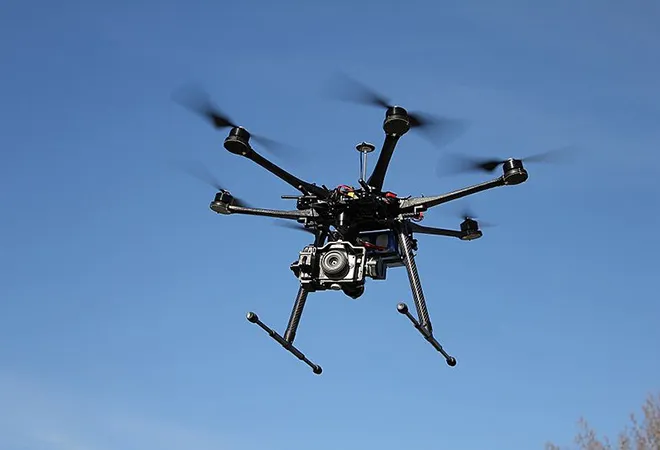
Immediately after the drone-delivered improvised explosive devices (IEDs) were used to attack the Indian Air Force Station (AFS) at Jammu, in the early hours of 27 June, media circles were abuzz about this new asymmetric threat. An IAF statement reported “two low intensity explosions… in the technical area of Jammu Air Force Station.” The statement is notable because the technical area of an air force station is where flying and other operational assets are housed—and is meant to be the most secure part of the station. Although Jammu is a relatively small base that normally hosts helicopters, not fighters or transports, it is in a sensitive part of the country, a mere 14 kilometre from the border with Pakistan, and is at least important enough to merit a runway expansion project scheduled for completion this year.
While the IAF statement said that equipment at the base was unharmed, and that only one of the blasts “caused minor damage to the roof of a building,” it is clear that the lack of destruction was entirely a matter of luck. Whether flying a pre-programmed path aided by satellite navigation and inertial measurement units (IMUs), or hand controlled to the point of release or impact, both methods have significant limitations that likely played a part in the relatively light effects. Satellite and IMU navigation is prone to errors over even moderate flight ranges, while manual control is subject to the limitations of line of sight, visibility and distance estimation of the target, and weak radio links. What is undeniable in all this is that the drones were not detected and managed to deliver explosives to the most secure enclave of an operational base. Future attacks might not be as ineffective.
Of course, regardless of the nature of damage at Jammu AFS, the attack itself signals a paradigm shift that will have to be catered for. The Indian military will now undoubtedly go into an overdrive to secure sensitive locations against similar repeat attacks. Early reports state that immediate plans are already underway at forward locations including deployment of “snipers, jammers, and other counter measures.”
The path to comprehensively address this challenge, however, is far from straightforward. Electric multi-rotor type drones used in the attack are cheap and can be easily procured off the shelf or assembled using retail-level components. They are also incredibly difficult to detect. Their small size grants them weak radar, thermal, and aural signatures, albeit varying based on the materials used in their construction. And detection difficulty is compounded when their size is coupled with low operating altitudes and slow speeds, making them harder to separate from clutter.
The path to comprehensively address this challenge, however, is far from straightforward. Electric multi-rotor type drones used in the attack are cheap and can be easily procured off the shelf or assembled using retail-level components. They are also incredibly difficult to detect
Then there is the matter of actually disabling such drones. Choosing between ‘soft’ and ‘hard’ kill options is not straightforward. In many cases, certainly in the present situation, a soft kill would be preferable to ascertain the origin of the drone. But in other cases, particularly in larger scale attacks with either more drones or more destructive payloads, rapid hard kills might be more appropriate. Whatever combination of detection and destruction is chosen, this protection is technology intensive and disproportionately expensive compared to the threat itself.
To make matters worse, some of the additional obstacles to defend against this threat are the result of old mistakes—either acts of omission or commission. Significant urban encroachment around defence establishments, particularly air bases, has run rampant. Frontline bases like Jammu are surrounded by unbuffered civilian construction. Even important fighter stations, like the Rafale base at Ambala, have multi-storey buildings overlooking the runway. In a 2019 incident, an IAF Jaguar pilot operating from Ambala was praised for saving civilians and his own aircraft after suffering multiple bird strikes resulting in an engine failure. No mention was made of the fact that the bird activity was a result of the massive urban encroachment around the station, and that no civilian lives would have been in danger to begin with, had zoning and construction norms been followed. In addition to providing vantage points for would-be attackers, urban encroachment provides precisely the sort of clutter that exacerbates the problem of drone detection. If not in the past, the issue certainly merits consideration now.
When Pakistani drones were being used to supply weapons and ammunition to terror networks on Indian soil, these deliveries were routinely intercepted, or at least stopped in action. Sales and transfers of commercial drones, or the hardware used to make basic multi-rotor drones are not easily monitored
Finally, with or without complex anti-drone systems that cater to various use cases, intelligence on terror attacks using drones must also improve. When Pakistani drones were being used to supply weapons and ammunition to terror networks on Indian soil, these deliveries were routinely intercepted, or at least stopped in action. Sales and transfers of commercial drones, or the hardware used to make basic multi-rotor drones are not easily monitored. But as past experience tackling the use of these methods by ISIS shows, intelligence, not defensive nets, are the most effective means of rapidly curtailing their use. Instead of detecting drones as they approach to attack, the most effective countermeasure is knowing when a bad actor first picks up a soldering iron and a circuit board.
The views expressed above belong to the author(s). ORF research and analyses now available on Telegram! Click here to access our curated content — blogs, longforms and interviews.




 PREV
PREV


